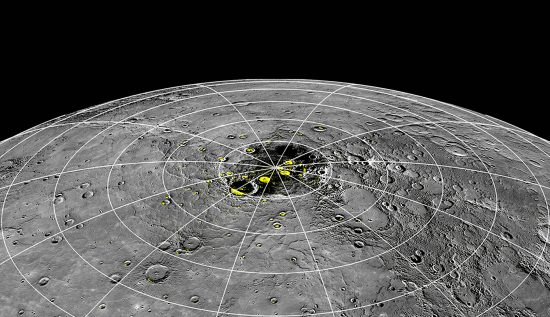
March 18, 2020
Frozen water on Mercury?
NASA launched the BepiColombo mission on October 20, 2018. The mission consists of two satellites: the Mercury Planetary Orbiter (MPO) and the Mercury Magnetospheric Orbiter (MMO). MPO is designed to study Mercury’s composition, while MMO will study Mercury’s magnetosphere.
One of BepiColumbo’s tasks is to “confirm” the presence of water ice on Mercury. Information from the defunct MESSENGER spacecraft indicates that there might be water ice and other frozen volatiles within the deep, permanently shaded craters found near Mercury’s north pole. The analysis was not conclusive, however, since the instruments onboard MESSENGER measured concentrations of hydrogen, interpreting those signals to be ice.
Recently, astrophysicists from the Georgia Institute of Technology announced that it was “chemistry” that is creating the ice in deeply shaded craters at Mercury’s north pole. According to Brant Jones, a researcher in Georgia Tech’s School of Chemistry and Biochemistry:
“This is not some strange, out-of-left-field idea. The basic chemical mechanism has been observed dozens of times in studies since the late 1960s. But that was on well-defined surfaces. Applying that chemistry to complicated surfaces like those on a planet is groundbreaking research.”
As the press release states, Mercury’s regolith contains hydroxyl groups (OH), created by hydrogen nuclei in the solar wind (protons). The heat on Mercury is said to “free up the hydroxyl groups”, which, in turn, causes them “smash into each other”, forming water molecules that “drift around the planet”.
Electric Universe advocate Wal Thornhill suggests another possibility:
“Water ice is a highly unlikely answer to the puzzle. Once again, there is an electrical possibility. Mercury is likely to have a weak dipolar magnetic field. Mercury, like all planets is connected to the solar circuit. That connection follows the magnetic field down to the poles. Any remanent magnetism of the electrical craters at the pole will tend to focus the plasma discharges upon those craters. In the near vacuum at Mercury’s surface, electrons will strike the surface and form more dense plasma. If sufficiently dense, the plasma layer acts like a metallic surface coating and returns a strong radar echo.”
Consensus theories cannot explain Mercury’s mixture of 5% iron, with a thin, silicon-rich crust, since the ratio of iron to silicon is opposite that of the other rocky planets. BepiColombo will investigate Mercury’s atmosphere. Temperatures there are greater than 400 Celsius at noon, and the planet receives nine times more radiation than Earth, so how does it have a detectable atmosphere?
A planet whose gravity is only 38% that of Earth, with such intense solar irradiation, should not exhibit even the thinnest atmosphere. Therefore, in the Electric Universe view, it is possible that Mercury is a young planet, like Titan (a possibly young moon of Saturn). So, it retains some of its primordial envelope, despite low gravity.
A previous Picture of the Day proposed that celestial bodies like Mercury should not be thought of as geriatric denizens of a wizened Solar System. Rather, given the anomalies, it is more appropriate to think of them as youthful members of a dynamic ensemble. If true, then there was a period in Mercury’s history when the surface was the scene of gigantic electric discharges pulling out craters, cutting vast chasms, and rearranging the atomic structure of the planet’s crust over large areas. Given those circumstances, no theories about Mercury will stand unless electricity is given its due.
Stephen Smith
The Thunderbolts Picture of the Day is generously supported by the Mainwaring Archive Foundation.












